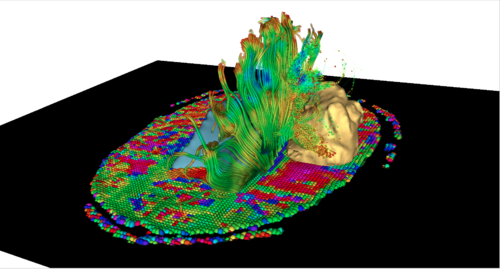Difference between revisions of "SPIE 2012 DTI Workshop"
| Line 6: | Line 6: | ||
The development of Diffusion Tensor Magnetic Resonance Imaging (DT-MRI) has opened up the possibility of studying the complex organization of the brain’s white matter in-vivo. By measuring the diffusion of water molecules in tissues, the technique gives insights into the structure and orientation of major white matter pathways, and DT-MRI findings have the potential to play a critical role in the extraction of meaningful information for diagnosis, prognosis and following of treatment response. | The development of Diffusion Tensor Magnetic Resonance Imaging (DT-MRI) has opened up the possibility of studying the complex organization of the brain’s white matter in-vivo. By measuring the diffusion of water molecules in tissues, the technique gives insights into the structure and orientation of major white matter pathways, and DT-MRI findings have the potential to play a critical role in the extraction of meaningful information for diagnosis, prognosis and following of treatment response. | ||
The course will guide participants through the fundamentals of the acquisition, analysis, and validation of DT-MRI data, as well as the challenges of transferring cutting-edge DTI techniques to clinical routine. The format will combine a series of lectures and hands-on sessions with the participants running DT-MRI analysis on their own laptops, to provide a conceptual understanding of the underlying theory of Diffusion Imaging, and a practical experience of extracting useful clinical information from DT-MRI images. | The course will guide participants through the fundamentals of the acquisition, analysis, and validation of DT-MRI data, as well as the challenges of transferring cutting-edge DTI techniques to clinical routine. The format will combine a series of lectures and hands-on sessions with the participants running DT-MRI analysis on their own laptops, to provide a conceptual understanding of the underlying theory of Diffusion Imaging, and a practical experience of extracting useful clinical information from DT-MRI images. | ||
| − | The hands-on sessions will use the 3DSlicer software, an open-source platform for medical image processing and 3D visualization used in biomedical and clinical research. This event is part of an on-going effort of the NIH-funded National Alliance for Medical Image Computing (NA-MIC) to transfer the latest advances in biomedical image analysis to the scientific and clinical community. | + | The hands-on sessions will use the [http://www.slicer.org/ 3DSlicer software], an open-source platform for medical image processing and 3D visualization used in biomedical and clinical research. This event is part of an on-going effort of the NIH-funded National Alliance for Medical Image Computing (NA-MIC) to transfer the latest advances in biomedical image analysis to the scientific and clinical community. |
== Venue== | == Venue== | ||
Revision as of 22:09, 29 September 2011
Home < SPIE 2012 DTI Workshop(Note: This a proposal under consideration.)
Course Description
The development of Diffusion Tensor Magnetic Resonance Imaging (DT-MRI) has opened up the possibility of studying the complex organization of the brain’s white matter in-vivo. By measuring the diffusion of water molecules in tissues, the technique gives insights into the structure and orientation of major white matter pathways, and DT-MRI findings have the potential to play a critical role in the extraction of meaningful information for diagnosis, prognosis and following of treatment response. The course will guide participants through the fundamentals of the acquisition, analysis, and validation of DT-MRI data, as well as the challenges of transferring cutting-edge DTI techniques to clinical routine. The format will combine a series of lectures and hands-on sessions with the participants running DT-MRI analysis on their own laptops, to provide a conceptual understanding of the underlying theory of Diffusion Imaging, and a practical experience of extracting useful clinical information from DT-MRI images. The hands-on sessions will use the 3DSlicer software, an open-source platform for medical image processing and 3D visualization used in biomedical and clinical research. This event is part of an on-going effort of the NIH-funded National Alliance for Medical Image Computing (NA-MIC) to transfer the latest advances in biomedical image analysis to the scientific and clinical community.
Venue
This is a workshop proposal for a Diffusion Tensor Imaging Workshop at SPIE 2012, Feb.4-9, San Diego, California.
Faculty
- Sonia Pujol, Ph.D., Surgical Planning Laboratory, Brigham and Women’s Hospital, Harvard Medical School
- Martin Styner, Ph.D.,Neuro Image Research and Analysis Laboratory, University of North Carolina
